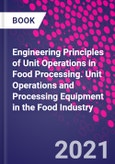Engineering Principles of Unit Operations in Food Processing, volume 1 in the Woodhead Publishing Series, In Unit Operations and Processing Equipment in the Food Industry series, presents basic principles of food engineering with an emphasis on unit operations, such as heat transfer, mass transfer and fluid mechanics.
Please Note: This is an On Demand product, delivery may take up to 11 working days after payment has been received.
Table of Contents
1. Introduction to unit operations and process description
Section 1 Fundamentals of food process engineering
2. Units and dimensions
3. General mathematical and engineering principles
4. Physical properties of food materials
5. Thermodynamic properties of food materials
6. Mass and energy balances
Section 2 Fluid mechanics and food rheology
7. Fluid mechanics
8. Rheological properties of food materials
Section 3 Heat and mass transfer in food engineering
9.�Conductive heat transfer
10. Convective heat transfer
11. Radiative heat transfer
12. Fundamentals of mass transfer
13. Psychrometry
Section 4 Application of mathematics and statistical approaches in food engineering
14. Modeling and optimization
15. Reaction kinetics
Authors
Seid Mahdi Jafari Associate Professor, Department of Food Materials and Process Design Engineering, Faculty of Food Science and Technology, University of Agricultural Sciences and Natural Resources, Pardis, Basidj Square, Gorgan, Iran.Dr. Seid Mahdi Jafari received his PhD degree in 2006 in Food Process Engineering from the University of Queensland, Australia. He has extensive experience in the field of food process engineering, conducting research on nanotechnology and its processes and being reviewer of some important journals as Innovative Food Science & Emerging Technologies, Journal of Food Engineering, Journal of Food Process Engineering, Industrial Crops and Products and Food Technology and Biotechnology. He is Associate Professor in the Department of Food Materials and Process Design Engineering, Faculty of Food Science and Technology, University of Agricultural Sciences and Natural Resources, Pardis, Basidj Square, Gorgan, Iran, and he is an academic member of GAU (Iran). He has published more than 85 papers in top-ranked international food science journals and 18 book chapters, along with editing four books with LAP and Elsevier publishers. In November 2015, he was awarded as one of the top 1% scientists of the world with the highest citations by Thompson Reuters (Essential Scientific Indicators) in the field of Biological Sciences.
1. "Encapsulation of Nano-Emulsions by Spray Drying� published by LAP (Germany), 2009,
2. "Nano-encapsulation Technologies for the Food and Nutraceutical Industries", Elsevier, 2017,
3. "Nano-encapsulation of Food Bioactive Ingredients; Principles and Applications", Elsevier, 2017,
4. "Nano-emulsions: Formulation, Characterization, and Applications", Elsevier, 2017 (co-edited with Prof. David Julian McClements).
5 . "Nanoencapsulation in the Food Industry Series�. This is a 7 volume series approved in 2017 that is going to be published over the course of 2019-2021.
and some book chapters such as:
� Jafari, S.M., Fathi, M., and Mandala, I.G., 2015. Chapter 13: "Emerging product formation" in the book "Food Waste Recovery: Processing technologies and industrial techniques", Edited by Galanakis, C., Elsevier. ISBN: 978-0-12-800351-0.
� Jafari, S.M. and McClements, D.J., 2017. Chapter 1: "Nanotechnology approaches for increasing nutrient bioavailability" in the book "Advances in Nutrition and Food Research (Vol. 81)", Edited by Toldra, F., Elsevier.
Locally in Iran, he has also published 20 books in Persian. In November, 2015, he was awarded as one of the top 1% scientists of the world with the highest citations by Thompson Reuters (Essential Scientific Indicators) in the field of Biological Sciences.








